1. 概论
inotify是Linux中用于监控文件系统变化的一个框架,不同于前一个框架dnotify, inotify可以实现基于inode的文件监控。也就是说监控对象不再局限于目录,也包含了文件。不仅如此,在事件的通知方面,inotify摈弃了dnotify的信号方式,采用在文件系统的处理函数中放置hook函数的方式实现。
2. 用户层
2.1 数据结构
在inotify中,对于一个文件或目录的监控被称为一个watch。 给某一个文件或目录添加一个watch就表示要对该文件添加某一类型的监控。监控的类型由一个掩码Mask表示,mask有:
IN_ACCESS : 文件的读操作
IN_ATTRIB : 文件属性变化
IN_CLOSE_WRITE : 文件被关闭之前被写
IN_CLOSE_NOWRITE : 文件被关闭
IN_CREATE : 新建文件
IN_DELETE : 删除文件
IN_MODIFY : 修改文件
IN_MOVE_SELF : 被监控的文件或者目录被移动
IN_MOVED_FROM : 文件从被监控的目录中移出
IN_MOVED_TO : 文件从被监控的目录中移入
IN_OPEN : 文件被打开
事件的类型有了,我们还需要一个结构体去表示一次事件, 在用户空间,inotify使用inotify_event表示一个事件,每一个事件都有一个特定的身份标示wd, wd是一个整型变量。每一个事件都有一组事件类型与其关联(IN_CREATE | IN_OPEN)。 事件中还应包含文件名。
struct inotify_event {
int wd;/* Watch descriptor */
uint32_t mask;/* Mask of events */
uint32_t cookie;/* Unique cookie associating related
events (for rename(2)) */
uint32_t len;/* Size of name field */
char name[];/* Optional null-terminated name */
};
2.2函数及inotify的使用
为了防止文件描述符fd的快速消耗,inotify提出了一个inotify instance(inotify实例)的概念。每一个inotify实例表示一个可读写的fd, 一个inotify实例链接有多个对于文件的watch。而函数inotify_init的工作就是生成一个inotify实例。
如何添加对于目标文件的watch呢?使用inotify_add_watch完成该任务,inotify_add_watch有三个参数,第一个参数是该watch所属的实例的fd, 第二个参数是被监控的文件名,第三个参数要监控的事件类型。
有添加就有删除, inotify_rm_watch(int fd, int wd)完成watch的删除工作,类似的, fd表示实例,wd表示即将删除的watch.
void handle_event(int fd){
for(;;){
int len =0;
char buf[BUFSIZE];
read(fd, buf, BUFSIZE);
int i =0;
char*p;
for(p = buf; p <(buf+len); p +=sizeof(struct inotify_event)+ even->len){
event =(struct inotify_event *)p;
if(event -> mask & IN_OPEN)
printf("IN_OPEN ");
}
}
}
int main(void){
int fd;
if((fd = inotify_init())<0){
perror("init error");
}
if(inotify_add_watch(fd,"/home", IN_OPEN|IN_DELETE)<0){
perror("add watch");
}
handle_event(fd);
return0;
}
从以上代码可以看出,inotify的使用很简单,由于一个inotify实例被抽象为一个文件,所以我们可以通过read函数直接读取其中的事件。
#include
int inotify_init(void);int inotify_init1(int flags);
int inotify_add_watch(int fd,constchar*pathname,uint32_t mask);
int inotify_rm_watch(int fd,int wd);
3. 内核原理
3.1 hook函数
inotify通过在文件系统的操作函数(vfs_open, vfs_unlink等)中插入hook函数改变代码的执行路径,从而产生相应的事件。以下是一个hook函数的列表:
图3-1 <图片来自引用1>
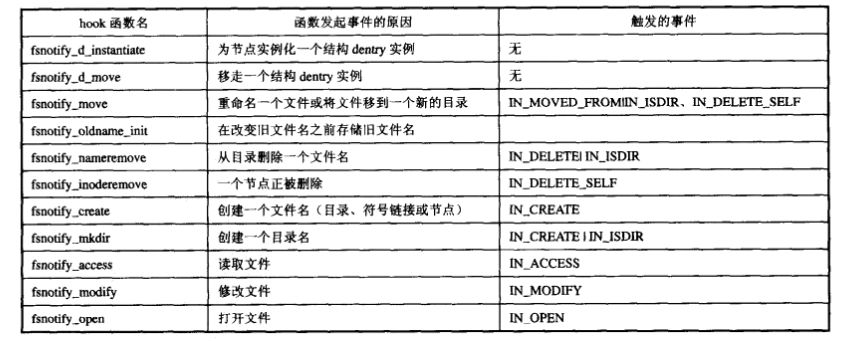
下图是sys_open函数的函数调用流程,可以看到sys_open函数调用的是fsnotify_open函数去处理open事件。
而fsnotify又调用inotify_dentry_parent_queue_event函数和inotify_inode_queue_event函数.
图3-2
其中inotify_dentry_parent_queue_event本身也调用了inode_queue_event函数,只是参数不同罢了.
图3-3
可见在inotify_dentry_parent_queue_event中,第一个参数变成了被监控目录的父目录的inode. 关于这两个函数,我们先按下不表, 留待后文再说.
3.2 inotifyfs (inotify.c)
在内核中inotify被抽象为一个虚拟文件系统. 在inotifyfs的初始化函数中,完成了以下三件事:
初始化inotifyfs( 调用register_filesystem() , kern_mount() )
设置事件队列的长度等
创建inotify_event和inotify_watch结构的slab缓存
图3-5
3.3 数据结构
3.2.1. inotify_device
struct inotify_device:表示一个inotify实例(inotify instance).,在linux2.16.13中,inotify是以模块的形式出现的,在module_init中会调用setup函数.
在inotify_device结构中保存有两个链表头部,一个事件链表,链表中保存的是该inotify实例上所有事件,另一个是watch链表,保存的是该实例上所有的watch.
struct inotify_device {
wait_queue_head_t wq; /* wait queue for i/o */
struct idr idr; /* idr mapping wd -> watch */
struct semaphore sem; /* protects this bad boy */
struct list_head events; /* list of queued events */
struct list_head watches; /* list of watches */
atomic_t count; /* reference count */
struct user_struct *user; /* user who opened this dev */
unsignedint queue_size; /* size of the queue (bytes) */
unsignedint event_count; /* number of pending events */
unsignedint max_events; /* maximum number of events */
u32 last_wd; /* the last wd allocated */
};
图3-7
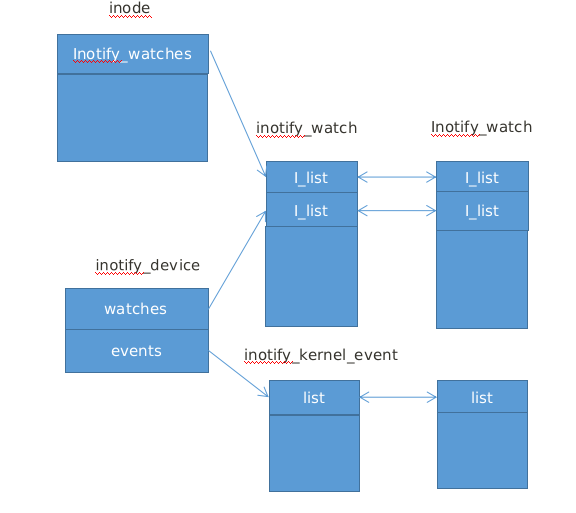
3.2.2 inotify_kernel_event
kernel_event结构封装了一个用户态的event结构, 代表相应文件产生的一次事件, 该结构链接在inotify_device中的events链表.
struct inotify_kernel_event {
struct inotify_event event;/* the user-space event */
struct list_head list;/* entry in inotify_device's list */
char *name;/* filename, if any */
};
3.2.2 inotify_watch
inotify_watch表示我们向文件添加一个监控. 他分别链接到两个链表,一个链表头在inode结构中, 另一个在inotify_device结构中.
struct inotify_watch {
struct list_head d_list;/* entry in inotify_device's list */
struct list_head i_list;/* entry in inde's list */
atomic_t count;/* reference count */
struct inotify_device *dev; /* associated device */
struct inode *inode;/* associated inode */
s32 wd; /* watch descriptor */
u32 mask; /* event mask for this watch */
};
3.3 深入api
接下来我以inotify的用户接口为例, 带大家深入探索一下这些函数究竟做了什么.
3.3.1 inotify_init
inotify_init函数的作用是给进程分配一个用于读写inotify事件缓冲区的一个fd.
图3-8
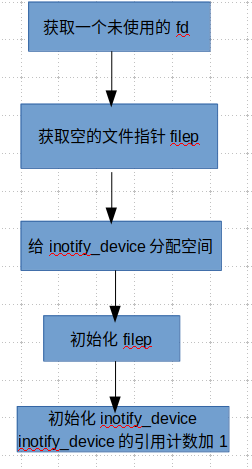
3.3.2 inotify_add_watch
inotify_add_watch有三个参数, watch所属的文件描述符,被监控的目标文件或者目录的路径, 事件掩码.
究竟add_watch是怎样的一个过程, 让我们拭目以待.
图3-9

3.4 事件究竟从何而来
上文提到, inotify在文件系统的每个文件操作函数中插入了一系列的钩子函数, 由此inotify就可以记录用户对于文件的各种操作. 简单粗暴有没有 … …
其中一个主要的函数是 inotify_inode_queue_event, 该函数的主要功能是遍历Inode的inotify_watches链表, 由watch为根, 找到挂在inotify_device上的事件, 并将事件插入事件队列(inotify_dev_queue_event).
图3-10
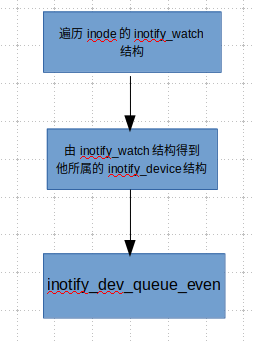
可以看到这个函数最终还是调用了inotify_dev_queue_event函数, inotify_dev_queue_event的主要功能是将生成事件并将其插入inotify_device结构的events链表.
总结
以上我以2.6.13版本的内核为例阐述了inotify框架的使用和原理. 本来打算是以最新版本内核为例的, 但是在4.15中, 内核合并dnotify inotify fanotify这三个框架并且抽象出一个新的接口fsnotify, 代码改动较大, 不利于讲解inotify的原理, 所以我选择了第一次合并inotify的2.6.13内核.
-
Linux
+关注
关注
87文章
11312浏览量
209695 -
函数
+关注
关注
3文章
4333浏览量
62686
原文标题:黄东升: inotify学习笔记
文章出处:【微信号:LinuxDev,微信公众号:Linux阅码场】欢迎添加关注!文章转载请注明出处。
发布评论请先 登录
相关推荐
请问keil debug时watch window里添加的变量怎么保存?
关于Inotify对linux文件系统的监控
对linux中的inotify机制的一点认识
请问u32 omap_bootmode=MMCSD_MODE_FAT要添加 bootmode的选择,该怎么添加?我想增加对nand的支持?
为工业物联网应用添加显示屏的DEVPACK-WATCH包括BOM,PCB文件及CAD文件
在USB库文件mass_mal.c中添加对flash和sd读写的函数
全志V853芯片 如何解决getevent运行出错,报错为“could not add watch for /dev/input”的问题?
如何在stm32mp1上添加对动画启动画面的支持呢?
关于KEIL5中在线仿真watch窗口的问题求解
教你如何给PDF文件添加水印
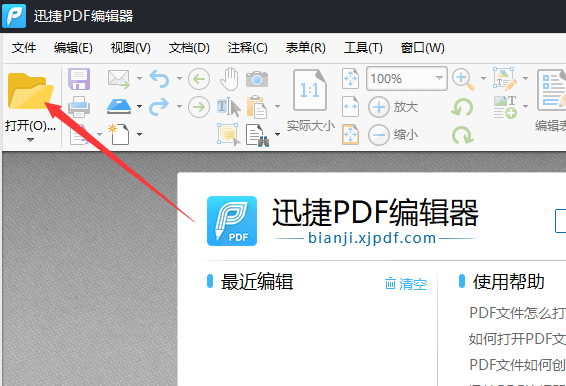




 inotify框架的使用和原理!如何添加对于目标文件的watch呢?
inotify框架的使用和原理!如何添加对于目标文件的watch呢?










评论